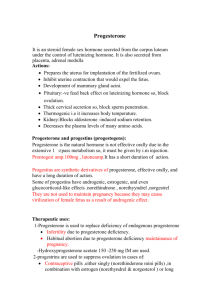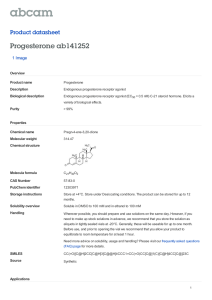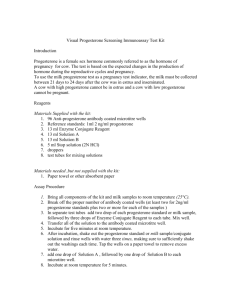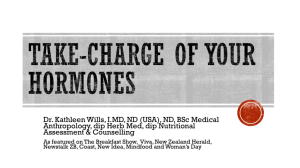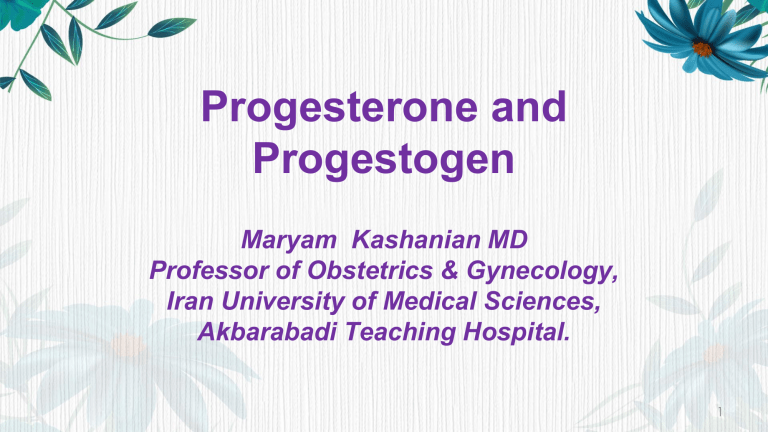
Progesterone and Progestogen Maryam Kashanian MD Professor of Obstetrics & Gynecology, Iran University of Medical Sciences, Akbarabadi Teaching Hospital. 1 • Besides the progestogenic effect, which is in common for all progestins, • There is a wide range of biological effects, • Which are different for the various progestins and • Have to be taken into account, • When medical treatment is considered. 2 Progestin side effects • • Bloating or water retention, weight gain and swelling (edema), Muscle, joint, or bone pain. • • Fatigue, headache, depression, Breast discomfort or enlargement, premenstrual syndrome (PMS)-like symptoms, drowsiness or insomnia, • Acne and hirsutism, • • Lipid profile Hypertension & Diabetes • • Ovulation Spotting 3 • Progestin Effects: • • • Progestational effects help: Prevent ovulation and Lessen menstrual bleeding. • • Androgenic effects : Unwanted side effects such as acne and body hair growth. • Some of the synthetic progestins are prodrugs, which need to be metabolized to become active compounds. 4 • There is evidence from in vitro and animal research that: • • • • The type of progestin, Formulation, Dose, and Route of delivery • Have a significant impact on efficacy • Progesterone is a steroid hormone derived from cholesterol • Progesterone is the main progestogen in the human body. • • Progestogen: Any natural or synthetic form of progesterone. • • Progestin: Specific for synthetic progestogens. • Progestins are functionally similar but structurally different from natural progesterone.( up to date 2021) 6 Progestin Generations • Progestins are classified as first to fourth generation progestins based on when they were first available, but • Different generations also have some different characteristics. Keep in mind that newer isn't necessarily better. • • First generation: Norethindrone, norethindrone acetate, and ethynodiol • Second generation: Desogestrel and norgestrel • Third generation: Norgestrel and norgestimate • Fourth generation: Drospirenone 8 Usual by Generation Classification ofClassification Synthetic Progestins Classification by Structure First Second — Third — Norethindrone Estranes Norethindrone acetate Desogestrel Gonanes Norgestrel Levonorgestrel Norgestimate Gestodene Pregnanes 9 Medroxyprogesterone acetate — — • Natural progestin, • Different classes of progestins, such as: • Retroprogesterone (i.e. dydrogesterone), • Progesterone derivatives (i.e. medrogestone) • 17-hydroxyprogesterone derivatives (i.e. chlormadinone acetate, cyproterone acetate, medroxyprogesterone acetate, megestrol acetate), • 19-norprogesterone derivatives (i.e. nomegestrol, promegestone, trimegestone, nesterone), • 19-nortestosterone derivatives norethisterone (NET), lynestrenol, levonorgestrel, desogestrel, gestodene, norgestimate, dienogest) and • Spironolactone derivatives (i.e. drospirenone). 12 Classification of Progestogens Progestogens Progesterone Retroprogesterone Spirolactone derivative Progesterone Dydrogesterone Drospirenone Progesterone derivatives 17-OH-progesterone derivatives Pregnane • Hydroxyprogesterone Caproate • Hydroxyprogesterone Heptanoate • Gestonorone Caproate • Chlormadinone Acetate • Medrogestone • Medroxyprogesterone Acetate • Cyproterone Acetate 19-progesterone derivatives Nor-Pregnane • Nomegestrole Acetate • Demegestone • Promegestone • Nestorone • Trimegestone Adapted from: Druckmann R. Journal Für Menopause. 2002:1-5 Testosterone derivatives 19-nortestosterone derivatives Estranes • Lynestrenol • Levonorgestrel • Norethisterone • Norethisterone Acetate • Ethinodiol Diacetate • Norgestrienone • Dienogest Gonanes • Norgestrel • Desogestrel • Gestodene • Norgestimate Progestins and receptors • All progestins bind to the progesterone receptors (PR) • And other steroid receptors: ➢ ➢ ➢ ➢ Estrogen receptor (ER) Androgen receptor (AR) Glucocorticoid receptor (GR) Mineralocorticoid receptor (MR) Differential Activity of Progesterone and Progestogens 19 Androgenic progestins • • Levonorgestrel (implant, hormonal IUDs, pill, emergency contraception) Norethindrone (mini-pill) • • Norethindrone acetate (pill) Norgestimate (pill) • • Desogestrel (pill, mini-pill) Etonogestrel (implant, vaginal ring) • • Norelgestromin (patch) Gestodene (pill) • Medroxyprogesterone acetate (weakly) (injection/shot) • • • Anti-androgenic progestins, Reduce the effect of the endogenous androgen and Decrease the incidence of acne and hirsutism, and lowering HDL. • • • Cyproterone acetate (pill) Drospirenone (pill) Dienogest (pill) • Progestins with anti-mineralocorticoid activity, Decrease bloating or water retention • • Gestodene (pill) Drospirenone (pill) – Different synthetic progestogens provide: • Focused progestational actions • Diverse specificities • Diverse side effects • Choice of progestogen will be balance of • Desired effects and • Undesired side-effects • Good compliance dependent on minimising side-effects 22 • There has been interest in synthesizing progestins that better mimic the natural hormone. Differential Actions of Progesterone and Progestogens Properties Dydrogesterone Progesterone Progesterone derivatives Testosterone & 19 nor-T derivatives Block ovulation –* + + + Estrogenic – + – + Androgenic – – + + Fetal masculinisation – – + + Uterine relaxation + + + – Adrenal atrophy – – + + Thermogenicity – + + + Blood clotting – – + + Blood lipids – – – + Retroprogesterone • It is a stereoisomer of the natural progesterone. • This configuration is ideal for interaction with the progesterone receptor, • The configuration is not as ideal for binding to other steroid hormone receptors, • Increased selectivity for the progesterone receptor. • Improved oral activity and metabolic stability, in comparison to progesterone Molecular Properties: Structure Dydrogesterone is a progesterone derivative1 CH3 Progesterone CH3 C O Norethisterone is a testosterone analog2 Testosterone CH3 CH3 CH3 10 10 H O 7 O 6 Dydrogesterone CH3 CH3 C O Norethisterone CH3 OH 17 CH3 10 10 H 7 O OH 17 6 O Differences in progestogen structure impact receptor selectivity and affinity, translating into different effects1–3 1. Kuhl Climacteric 2005; 2. Stanczyk et al. Endocr Rev 2013; 3. Kuhnz et al. Contraception 1997 C CH Dydrogesterone • • • • • • Is a synthetic progestational hormone, (developed in the 1950s and introduced for medical use in 1961) It is structurally and pharmacologically similar to natural progesterone Due to its unique structure, binds almost exclusively to the progesterone receptor Is a highly selective progestogen, and Does not bind importantly to the androgen, estrogen, or glucocorticoid receptor. NO androgenic or antiandrogenic, estrogenic or antiestrogenic, and glucocorticoid or antiglucocorticoid activity. Dydrogesterone • Binds to the mineralocorticoid receptor and possesses antimineralocorticoid activity (weak ). • • • Is an orally-active progestogen, good oral bioavailability Is completely metabolized Its major active metabolite; 20α-dihydrodydrogesterone (20α-DHD), has progestogenic activity • • Is an atypical progestogen and does not inhibit ovulation No increase in temperature. Dydrogesterone • • • The oral route of administration : More patient-friendly regimen ; Improve compliance to treatment. • • It has a role as a progestin. Produces a complete secretory endometrium in an estrogenprimed uterus Protection for estrogen induced increased risk for endometrium hyperplasia and/or carcinogenesis. • • It is indicated in all cases of endogenous progesterone deficiency • 1: Barbosa et al. Oral dydrogesterone vs. vaginal progesterone capsules for luteal-phase support in women undergoing embryo transfer: a systematic review and meta-analysis. JBRA Assist Reprod. 2018 Apr-Jun; 22(2): 148–156. Receptor Binding of Progestogens1,2 Biological activity Dydrogesterone Progesterone Norethisterone MPA Progestogenic + + + + Blocking ovulation –a + + + Thermogenicity – + + + Anti-gonadotropic – + + + Anti-estrogenic + + + + Estrogenic – – + – Androgenic – – + ± Anti-androgenic ±b ± – – Glucocorticoid – + – + Anti-mineralocorticoid ± + – – Dydrogesterone is selective for the progesterone receptor, reducing the likelihood of other receptor-related side effects1–4 aAt normal dosage; bDydrogesterone has less pronounced anti-androgenic effects than progesterone4 1. Schindler AE, et al. Maturitas 2008; 61(1–2):171–180. 2. Schindler AE. Maturitas 2009; 65(Suppl 1):S3–S11. 3. Dydrogesterone CCDS. 15 January 2016. 4. Rižner TL, et al. Steroids 2011; 76(6):607–615. Dydrogesterone Affinity to Receptors • Dydrogesterone is selective for the progesterone receptor, • Reducing the likelihood of other receptor-related side effects1–4 Schindler AE et al. Classification of Progestins. Maturitas 2003; 46SI:S7-S16 Molecular Properties: Transformation of the Endometrium Dydrogesterone and norethisterone induce in-phase secretory transformation of the endometrium aPostmenopausal women were treated with conjugated estrogens (every day) and an oral progestogen (for the last 6–12 days of the month); curettage was performed to obtain endometria after 6 days of progestogen treatment Reprinted by permission from the American Society for Reproductive Medicine (Fertility and Sterility, 1986, 46, 1062–1066) Progesterone Receptor Affinity Dydrogesterone has ~1.5 times higher affinity to progesterone receptors than progesterone1 Affinity to progesterone receptor1 75% Dydrogesterone 50% Progesterone 75% Norethisterone 115% Medroxyprogesterone acetate Dihydrodydrogesterone, the main metabolite of dydrogesterone, also has progestogenic activity1–3 1: Schindler AE, et al. Maturitas 2008; 61(1–2):171–180. 2: Schindler AE. Maturitas 2009; 65(Suppl 1): S3–S11. 3: drogesterone CCDS. 15 January 2016 Molecular Properties: Receptor Affinity Progesterone receptor 75% dydrogesterone and norethisterone Dydrogesterone and norethisterone have equal affinity for the progesterone receptor Androgen receptor 0% vs15% dydrogesterone norethisterone Unlike dydrogesterone, norethisterone also has affinity for the androgen receptor Dydrogesterone is highly selective for the progesterone receptor, whereas norethisterone also has affinity for the androgen receptor Schindler et al. Maturitas 2008 Molecular Properties: Pharmacokinetics Parameter Absorption Bioavailability Main metabolites Elimination Dydrogesterone1 Norethisterone2–4 Rapidly absorbed (Tmax 0.5–2.5 h) Rapidly absorbed (Tmax 1.5±0.6 h) 28% 47–73% 20α-dihydrodydrogesterone (progestogenic) Ethinyl estradiol (estrogenic), 5α-dihydronorethisterone (androgenic) Long stable effects (t1/2 5–7 h) Long stable effects (t1/2 5–13 h) Dydrogesterone and its metabolites are purely progestogenic1 Metabolites of norethisterone are androgenic and estrogenic2–3 1. Abbott Laboratories. Dydrogesterone CCDS. 2016; 2. Bayer. Primolut N® Product Information. 2013; 3. Kuhnz et al. Contraception 1997; 4. Kuhl Climacteric 2005 Dydrogesterone is the only one with no antigonadotrophic effects Schindler AE et al. Classification of Progestins. Maturitas 2003; 46SI:S7-S16 Dydrogesterone does not Modify Plasma Levels of Endogenous Progesterone • No significant depression in • Plasma Progesterone levels • In patients on Dydrogesterone Balasch J et al. The effect of postovulatory administration of dehydrogesterone on plasma progesterone levels. Fertil Steril 1980; 34(1):21-23. 38 39 Dose to Inhibit Ovulation Blocking of Ovulation Doses of Different Progrestogens Dydrogesterone: 30mg/day MPA*: 5mg/day Norethinsterone: 0.5mg/day * Medroxy-progesterone Schindler AE, Campagnoli C, Druckmann R, et al. Classification and pharmacology of progestins. Maturitas. 2008;61(1–2):171–180. Dydrogesterone and Micronized Progesterone Are Synthesized from a Natural Source Dydrogesterone is a retroprogesterone, a stereoisomer of progesterone, with an additional double-bond between carbon 6 and 71 •Dydrogesterone, shaped by light,2 enhances the progestogenic effects3 – No estrogenic, androgenic, or glucocorticoid effects3 – Does not inhibit ovulation, at normal dosage3 – Anti-androgenic potential of dydrogesterone is less pronounced in comparison to progesterone4 Progesterone Dydrogesterone CH3 CH3 C CH3 O CH3 CH3 O CH3 H O C H O 1. Kuhl H. Climacteric 2005; 8 (Suppl 1): 3–63. 2. Fischer M. Agnew Chem Int Ed Engl 1978; 17: 16-26 3. Schindler AE. Maturitas 2009; 65S: S3–S11. 4. Rižner TL et al. Steroids. 2011;76(6):607–15 Safety and Tolerability Dydrogesterone • Most commonly reported AEs (clinical trials): Migraines/headache, nausea, menstrual disorders and breast pain/tenderness1 • No androgenic activity1 • Minimal to neutral effects on lipid metabolism, glucose tolerance or blood coagulation2–5 Norethisterone • Most commonly reported AEs (clinical trials and post-marketing): headache, nausea, uterine/vaginal bleeding and edema6 • Androgenic and estrogenic activity6 • Impacts lipid metabolism, glucose metabolism and blood coagulation7,8 Dydrogesterone has been used for more than 55 years, in an estimated 94 million patients, and benefits from a well-established safety profile; over 20 million pregnancies have been exposed to dydrogesterone in utero9 AE, adverse event Not head-to-head comparison – for illustrative purposes only 1. Abbott Laboratories. Dydrogesterone CCDS. 2016; 2. Lacey et al. Br J Clin Pract 1983; 3. Godsland et al. Clin Endocrinol (Oxf) 2004; 4. Gelfand et al. Menopause 1997; 5. Seeger & Mueck Gynecol Endocrinol 2007; 6. Bayer. Primolut N® SPC. 2015; 7. Lehmann et al. Contraception 1993; 8. Fahmy et al. Contraception 1991; 9. Podzolkova et al. Gynecol Endocrinol 2016 Dydrogesterone • Have no side effects on the mother. • Has a good safety and tolerability profile , and few side effects. • Has no androgenic effects on the fetus, and • Does not inhibit the formation of progesterone in the placenta. • Only Pelinescu-Onciul’s reported drowsiness. • Gelle and Schaeffer reported nausea and vomiting, but in only one patient, and • Chang, reported nausea and vomiting in two patients. • However, nausea and vomiting may be due to early pregnancy itself rather than the medication Conclusions • Dydrogesterone • Very similar to progesterone, but is orally bioavailable1 • Highly selective for the progesterone receptor, and its metabolites are progestogenic1 • Does not inhibit endogenous progesterone secretion2 • Does not inhibit ovulation at recommended therapeutic dose3 • Effectively transforms estrogenized endometrium4 • Suitable for treatment of a variety of menstrual disorders5 • Recent studies have further demonstrated its effectiveness in regularizing menstrual cycles6,7 and reducing menstrual bleeding7,8 and pain6,7 1. Schindler AE, et al. Maturitas. 2008; 61(1–2):171-180. 2. Balasch J, et al. Fertil Steril 1980; 34(1): 21–23. 3. Kuhl H. Climacteric 2005; 8(Suppl 1): 3–63. 4. Karakus S, et al. Aust N Z J Obstet Gynaecol 2009; 49(6): 685–688. 5. Dydrogesterone CCDS. 15 January 2016. 6. Podzolkova N et al. Gynecol Endocrinol 2016 Mar;32(3):246–9. 7. Trivedi N et al. Gynecol Endocrinol 2016. 8. Tajjamal A and Zaman F. Gazzetta Medica Italiana 2015; 174(9):391–398 Thank You ! Questions?
